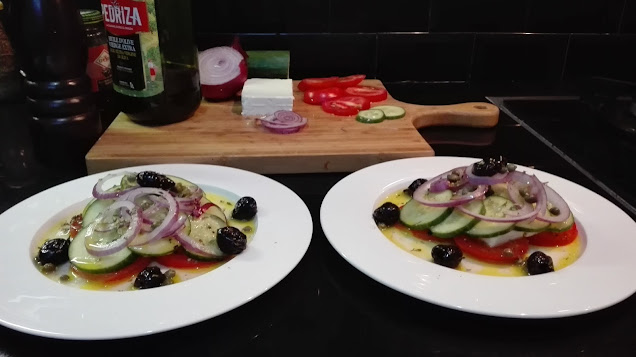Traditionally Greek salad is made with pieces of tomatoes, sliced cucumbers, onion, Feta cheese (served in a single rectangular-shaped cutting put over the vegetables), and olives (usually Kalamata olives), typically seasoned with salt and oregano, and dressed with olive oil.
GREEK CUISINE AND THE 19TH CENTURY INVASION OF THE TOMATO
Amazingly, it’s the same dish that is also one of the most popular lunch options in the United States – the Greek Salad
In Greece we call it ‘Horiatiki’, which means village or peasant salad – basically a combination of tomatoes, onions, cucumbers, green peppers, olives and feta cheese, dressed in olive oil and sprinkled with oregano. Please also note that an authentic Greek salad does not include lettuce. It is quite common for Greeks to eat seasonally. A Greek salad is primarily a summer dish, and since lettuce only grows in Greece during the winter months a traditional ‘Horiatiki’ salad does not include lettuce.
Before we take a closer look at our key ingredient – the tomato – let’s consider the history of this lovely salad. From its Greek name we assume that it was a rural dish. It is true that the salad’s essential ingredients were often what a farmer would take to the field for his mid-morning snack, only he would keep the ingredients uncut and wrapped in a cloth with a piece of bread. When the time came, he would bite straight into his chunk of feta, his tomato and even (quite heroically) his onion!
The salad’s exact origin is debatable, but one thing we can be sure of is that the Greek Salad is not part of the country’s long established traditional cuisine. We know this because, incredibly, the tomato did not become popular in Greece until the end of the 19th, beginning of the 20th century. This is hard to believe, considering how fast it’s made itself a home here in Greece.
The Tomato Invades Europe
Tomato seeds were first brought to Europe from South America by the Conquistadors, but due to the plant’s resemblance to atropa belladonna (Deadly nightshade) it was viewed with suspicion and grown purely ornamentally. The Italians were among the first to brave the tomato. Tomato recipes began making an appearance in Italy towards the end of the 16th century, but tomato seeds were not introduced to Greece until 1818 when the country was still part of the Ottoman Empire. Shortly thereafter, in 1821, the country embarked on a war of independence and everyone was simply too preoccupied with the war to be overly concerned with this strange new fruit.
The first tomatoes to grow in Greece were on the island of Syros. Not long after, the petite waterless tomato, similar to the cherry tomato was first grown in Santorini. To this day these tomatoes still thrive on Santorini’s rich volcanic soil, sunshine and heavy morning dew. In 1915 the first canning plant opened in Nauplion, supplied by increasing tomato production in the nearby plains of the Argolis. It wasn’t long before the tomato quickly became one of the main ingredients of Greek cuisine.
Before the Tomato Conquered Greece
Today, it’s hard to imagine a time when iconic Greek dishes such as ‘domates yemistes’ (stuffed tomatoes), ‘kokkinisto’ (literally ‘reddened’ meat stew) and countless others, including, of course, the ubiquitous Greek Salad, were unheard of. Whatever did we eat before the invasion of the tomato?
Many ancient Greek tales tell us of heroes roasting oxen, sheep and goats over an open flame in honor of the gods and of course for their own enjoyment – the two always seemed to go together, and few found fault in this. The diet also consisted of milk, yogurt and cheese – Cheese that was very similar to the modern day feta. They made bread from barley and wheat. They preserved and ate olives and used olive oil in their cooking. They grew vegetables in their gardens, set out fishing nets on the sea, and searched the rocky coasts for octopus and other seafood. Sugar did not exist in those days, but the ancients satisfied their ‘sweet tooth’ with honey and fruit – grapes and figs were especially prized and eaten both fresh and dried. Wine was an important part of any meal.
It was the Greeks who produced the first ever cook book. Debating food and the best ways to enjoy it was a common practice. Some traditionalists insisted that meat and bread were the proper ‘manly’ diet and scorned the fancy cooking and more delicate dishes advocated by others. They in turn considered the ‘carnivores’ barbaric and unrefined. Then there were those who argued in favor of a purely vegetarian diet as being more civilized. It all sounds very familiar, doesn’t it?
A Culinary Love Affair
Much of Greek cuisine has remained intact since antiquity, merely expanding to include new ingredients as they were introduced. Approaches to eating haven’t changed either. In the 1st century AD, Plutarch wrote, “We do not sit at the table to eat… but to eat together” – an attitude that prevails in Greece to this day.
Even though we might conclude that Greeks managed extremely well without all the ‘reddened’ dishes we enjoy today, I’m not giving up on tomatoes. They thrive in the Greek sunshine and our long, dry summers. Despite all I know of their history, they still seem quintessentially Greek to me, deeply entrenched in what we eat and how we see ourselves. So, ‘kali orexi’ (bon appétit) and pass the Greek salad!
private chefs and event catering
Palm Beach + Boca Raton + Fort Lauderdale + Miami Beach
info@yadachef.com | 954-367-YADA (9232)
561-285-7466
south florida catering and personal chefs



